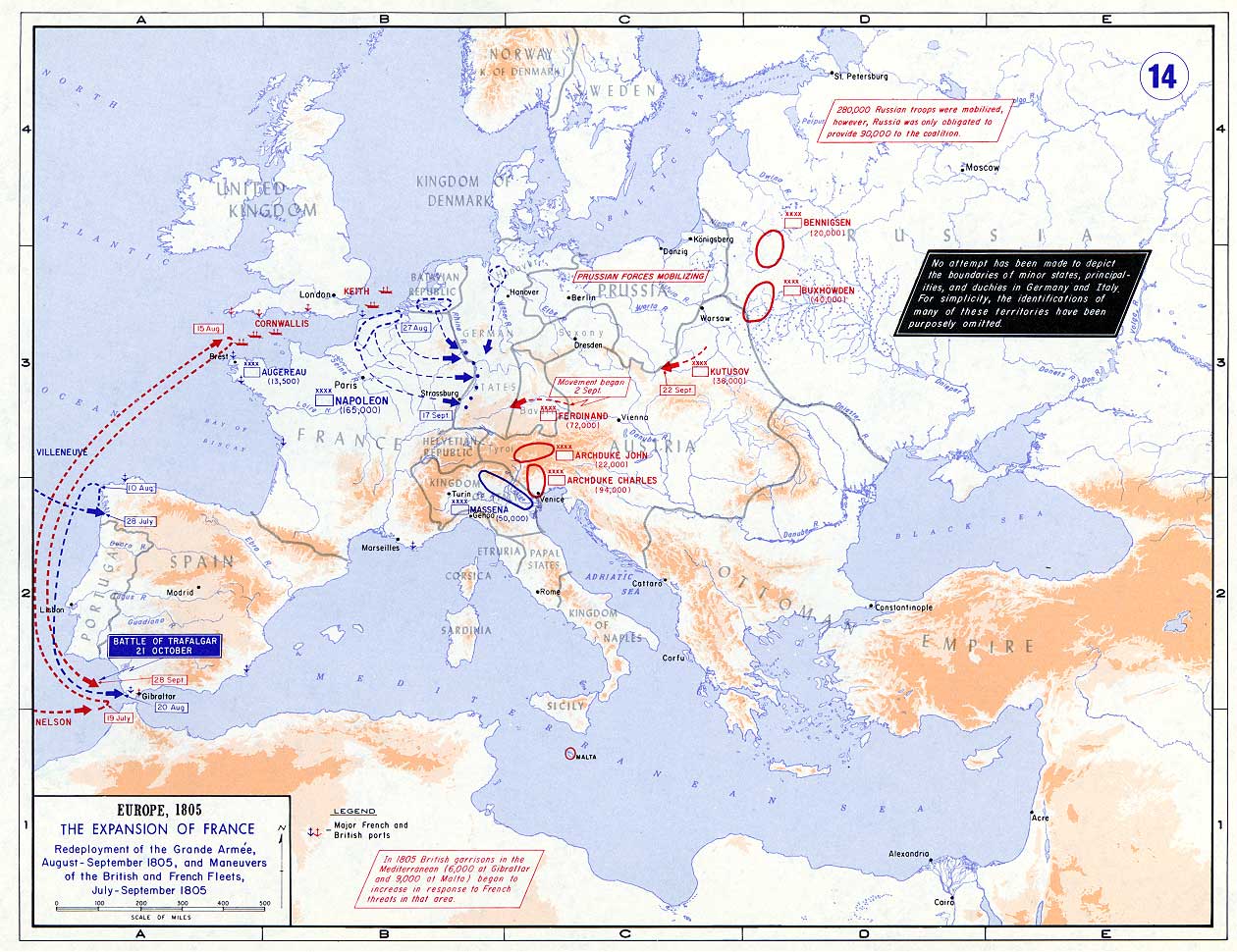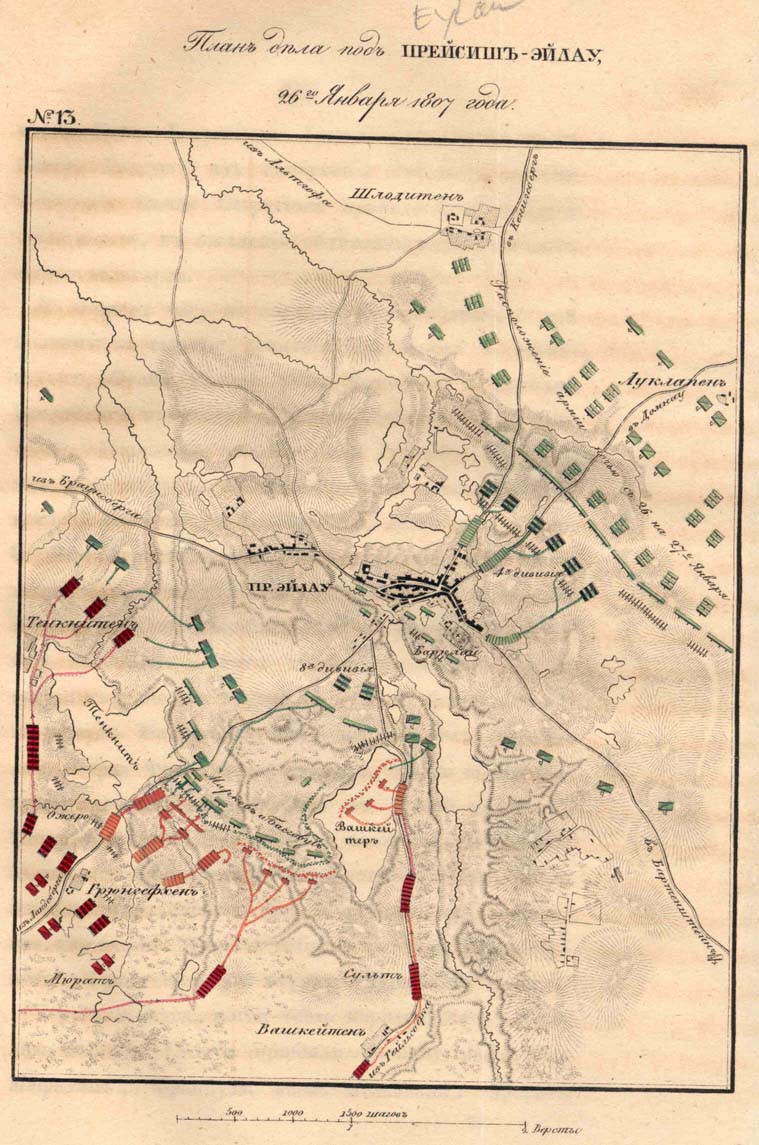|
Eugène-Casimir Villatte
Eugène-Casimir Villatte, comte d'Oultremont (; 14 April 1770 – 14 May 1834) fought in the French army during the Wars of the French Revolution and the Napoleonic Wars. He rose to command a division at many of the important battles in the Peninsular War. His is one of the names inscribed under the Arc de Triomphe. Early career Born in Longwy as part of the House of d'Oultremont, Villatte joined the army and was a sous-lieutenant (second lieutenant) at the beginning of the French Revolution. After joining the military in January 1792, his first assignment was as lieutenant of the 13th infantry. In 1795 he served as an aide to Jean-Baptiste Bernadotte and later as an adjutant-commandant. He rose to the rank of general of brigade in 1803. Empire During the Ulm Campaign in 1805, he commanded a brigade under Marshal Michel Ney at the Battle of Elchingen. Still under Ney, he fought at the Battle of Jena and the capture of Magdeburg in 1806. After leading his brigade at the combat ... [...More Info...] [...Related Items...] OR: [Wikipedia] [Google] [Baidu] |
Longwy
Longwy (; older , ; ) is a Communes of France, commune in the Departments of France, French department of Meurthe-et-Moselle, Lorraine, administrative region of Grand Est, northeastern France. The inhabitants are known as ''Longoviciens''. In 2008, the ''ville neuve'' ("New Town") was listed as a UNESCO World Heritage Site, as part of the "Fortifications of Vauban" group for its contributions to the development of military architecture and engineering. Economy Longwy has historically been an industrial center of the Lorraine (province), Lorraine iron mining district. Factories lined the river in historic postcards. The town is also known for its artistic faience, produced there since 1798. It is produced today by the Société des faïenceries de Longwy et Senelle, often in cooperation with artists and ceramists. Overglaze decoration, Overglaze enamel decoration, known as ''émaux'' and often in a manner similar to cloisonné, has been produced in Longwy ceramics since 1872. ... [...More Info...] [...Related Items...] OR: [Wikipedia] [Google] [Baidu] |
Ulm Campaign
The Ulm campaign was a series of French and Bavarian military maneuvers and battles to outflank and capture an Austrian army in 1805 during the War of the Third Coalition. It took place in the vicinity of and inside the Swabian city of Ulm. The French , led by Emperor Napoleon, had 210,000 troops organized into seven corps and hoped to knock out the Austrian army in the Danube before Russian reinforcements could arrive. Rapid marching let Napoleon conduct a large wheeling maneuver, which captured an Austrian army of 60,000 under Feldmarschall-Leutnant (FML) Karl Freiherr Mack von Leiberich on 20 October at Ulm. The campaign is by some military historians regarded as a strategic masterpiece and was influential in the development of the Schlieffen Plan in the late 19th century. Napoleon himself wrote: :''four months of marching about, months of fatigue and wretchedness, have proved to me that nothing is more hideous, more miserable, than war. And yet our sufferings in the G ... [...More Info...] [...Related Items...] OR: [Wikipedia] [Google] [Baidu] |
Claude Victor-Perrin, Duc De Belluno
Claude-Victor Perrin, Duke of Belluno (; 7 December 1764 – 1 March 1841) was a French military commander who served during the French Revolutionary Wars and the Napoleonic Wars. He was made a Marshal of the Empire in 1807 by Emperor Napoleon I. Early life Victor was born in Lamarche on 7 December 1764 to Charles Perrin and Marie Anne Floriot. In 1781, he enlisted in an artillery regiment in Grenoble as a drummer, and after ten years' service he applied for and received his discharge. In Valence, on 16 May 1791 he married Jeanne Josephine Muguet, by whom he had issue which was extinct in the male line by 1917. French Revolutionary Wars War of the First Coalition In February 1792, Victor joined his hometown's National Guard as a grenadier. He then enlisted in the 1st Drôme Battalion, and later passed to the 5th Bouches-du-Rhône Battalion. In September 1792 he was made chief of battalion and deployed with the Army of Italy, distinguishing himself at the Battle of ... [...More Info...] [...Related Items...] OR: [Wikipedia] [Google] [Baidu] |
Battle Of Valmaseda
The Battle of Valmaseda (or Balmaseda) took place on 5 November 1808, during Lieutenant-General Blake's retreat from superior French armies in northern Spain. Reinforced by veteran regular infantry from General La Romana's Division of the North (), Blake's force suddenly turned on its pursuers and ambushed Marshal Victor's errant vanguard under ''Général de division'' Villatte. Background Napoleon's invasion of Spain had started with the Battle of Zornoza, where Marshal François Lefebvre's failed to destroy the Spanish army, as Blake had shaken off the premature French assault and escaped with his army intact. Further mistakes were made in the French pursuit, namely when Victor carelessly allowed his Army Corps to spread out in its search for an enemy he regarded as beaten. Forces French Major-General Eugene-Casimir Villatte commanded the 3rd Division of Lefebvre's IV Corps. This oversized unit included three battalions each of the 27th Light, 63rd, 94th and 95th ... [...More Info...] [...Related Items...] OR: [Wikipedia] [Google] [Baidu] |
Army Of Galicia
The Army of Galicia (Spanish: ''Ejército de Galicia'') was a Spanish field army that took part in the Peninsular War against Napoleon’s French Grande Armée. Created by the Supreme Junta towards the end of June 1808 to hold the Spanish left wing along the Cantabrian mountains against Napoleon's forces, it had a paper force of 43,000 regulars. Command was first given to General Blake, and then, in November 1808, to General La Romana. Battle of Medina del Rio Seco Following the defeat of General Cuesta's small and inexperienced Army of Castile at the Battle of Cabezón, which had forced Cuesta to abandon his seat of command at Valladolid to General Lasalle and escape to Benavente, Blake was ordered to combine the troops of his newly formed army with what was left of Cuesta's forces. Blake had initially turned down a request to do so as the troops were still undergoing training and far short of their full numbers. Setting off with 27,000 foot soldiers and 150 cavalrymen, ... [...More Info...] [...Related Items...] OR: [Wikipedia] [Google] [Baidu] |
Anton Wilhelm Von L'Estocq
Anton Wilhelm von L'Estocq (16 August 1738 – 5 January 1815) was a Prussian cavalry general best known for his command of the Prussian troops at the Battle of Eylau. Biography L'Estocq was born in Celle, Electorate of Hanover, the son of a Huguenot Prussian officer. In 1757 he became a cadet officer of the Gensd'armes regiment of Berlin. During the Seven Years' War, he participated in the battles of Zorndorf, Kunersdorf, and Torgau. After a battle near Langensalza, he received the Pour le Mérite. In 1768 L'Estocq became first lieutenant and served in the hussar regiment of General Hans Joachim von Zieten. Initially Zieten's adjutant, he was promoted successively to cavalry captain, major, lieutenant colonel, and colonel. In 1779, L'Estocq was stationed near Fehrbellin, where he assisted General Zieten with the regimental business in that area. In 1790 King Frederick William II of Prussia named L'Estocq battalion commander of the Regiment von Eben (2nd Hussar Regim ... [...More Info...] [...Related Items...] OR: [Wikipedia] [Google] [Baidu] |
Battle Of Guttstadt-Deppen
In the Battle of Guttstadt-Deppen on 5 and 6 June 1807, troops of the Russian Empire led by General Levin August, Count von Bennigsen attacked the First French Empire corps of Marshal Michel Ney. The Russians pressed back their opponents in such a way that saw Ney fight a brilliant rearguard action with his heavily outnumbered forces. During the 6th, Ney successfully disengaged his troops and pulled back to the west side of the Pasłęka (Passarge) River. The action occurred during the War of the Fourth Coalition, part of the Napoleonic Wars. Dobre Miasto (Guttstadt) is on Route 51 about southwest of Lidzbark Warmiński (Heilsberg) and north of Olsztyn (Allenstein). The fighting occurred along Route 580 which runs southwest from Guttstadt to Kalisty (Deppen) on the Pasłęka. At the beginning of June, Bennigsen launched an offensive against the forces of Emperor Napoleon I in East Prussia. The Russian commander planned to trap Ney's corps between several converging colum ... [...More Info...] [...Related Items...] OR: [Wikipedia] [Google] [Baidu] |
Spędy
Spędy is a village in the administrative district of Gmina Wilczęta, within Braniewo County __NOTOC__ Braniewo County () is a unit of territorial administration and local government (powiat) in Warmian-Masurian Voivodeship, northern Poland, on the border with Russia. It came into being on January 1, 1999, as a result of the Polish local ..., Warmian-Masurian Voivodeship, in northern Poland. References Villages in Braniewo County {{Braniewo-geo-stub ... [...More Info...] [...Related Items...] OR: [Wikipedia] [Google] [Baidu] |
Pasłęka
The Pasłęka (; ) is a river in northern Poland that debouches into the Baltic Sea on the Vistula Lagoon near Braniewo. It flows through the Olsztyn and Mrągowo lakelands, and through Gdańsk Coastal Area. The reported length of the river varies, depending on sources, from . The river springs nearby Olsztynek, between Stawiguda and Gryźliny, at AMSL; though some sources place it in the Pasłęk reservoir, which lies at AMSL. The river flows through the town of Braniewo. The drainage area of Pasłęka spreads over . Pasłęka's average mouth discharge equals . The whole length of the river is covered by River Pasłęka Beaver Refugium nature reserve. Pasłęka is one of Warmia's two main rivers, accompanied by Łyna. Pasłęka divides two historical lands: Warmia and Upper Prussia (''Powiśle''), consequently for centuries bordering Polish Warmia and the Polish fiefdoms of the Teutonic Order and Ducal Prussia. In the 2007 water quality survey conducted on Pasłęk ... [...More Info...] [...Related Items...] OR: [Wikipedia] [Google] [Baidu] |
Battle Of Eylau
The Battle of Eylau (also known as the Battle of Preussisch-Eylau) was a bloody and strategically inconclusive battle on 7 and 8 February 1807 between Napoleon's and the Imperial Russian Army under the command of General Levin August von Bennigsen near the town of Bagrationovsk, Preussisch Eylau in East Prussia. Late in the battle, the Russians received timely reinforcements from a Kingdom of Prussia, Prussian division of Anton Wilhelm von L'Estocq, von L'Estocq. After 1945, the town was renamed Bagrationovsk as part of Kaliningrad Oblast, Russia. The engagement was fought during the War of the Fourth Coalition, part of the Napoleonic Wars. Napoleon's armies had smashed the army of the Austrian Empire in the Ulm Campaign and the combined Austrian and Russian armies at the Battle of Austerlitz on 2 December 1805. On 14 October 1806, Napoleon crushed the armies of the Kingdom of Prussia at the Battle of Jena–Auerstedt and hunted down the scattered Prussians at Battle of Pren ... [...More Info...] [...Related Items...] OR: [Wikipedia] [Google] [Baidu] |
Magdeburg
Magdeburg (; ) is the Capital city, capital of the Germany, German States of Germany, state Saxony-Anhalt. The city is on the Elbe river. Otto I, Holy Roman Emperor, Otto I, the first Holy Roman Emperor and founder of the Archbishopric of Magdeburg, was buried in the city's Magdeburg Cathedral, cathedral after his death. Magdeburg's version of German town law, known as Magdeburg rights, spread throughout Central Europe, Central and Eastern Europe. In the Late Middle Ages, Magdeburg was one of the largest and most prosperous German cities and a notable member of the Hanseatic League. One of the most notable people from the city was Otto von Guericke, famous for his experiments with the Magdeburg hemispheres. Magdeburg has experienced three major devastations in its history. In 1207 the first catastrophe struck the city, with a fire burning down large parts of the city, including the Magdeburg Cathedral#Previous building, Ottonian cathedral. The Catholic League (German), Catholi ... [...More Info...] [...Related Items...] OR: [Wikipedia] [Google] [Baidu] |



